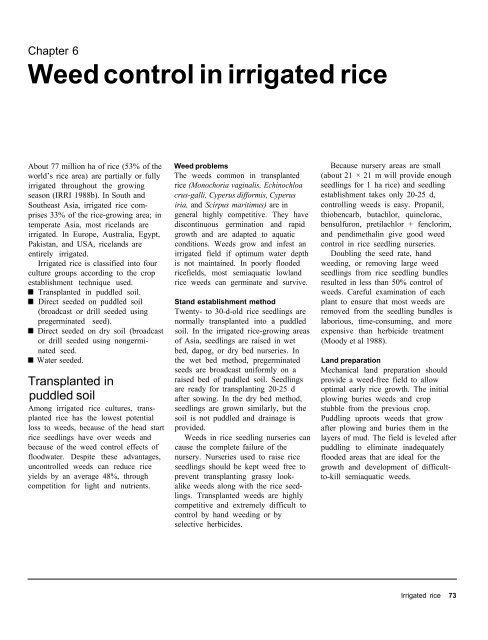A handbbok on Weed Control in Rice.pdf
A handbbok on Weed Control in Rice.pdf
A handbbok on Weed Control in Rice.pdf
Create successful ePaper yourself
Turn your PDF publications into a flip-book with our unique Google optimized e-Paper software.
Chapter 6<br />
<strong>Weed</strong> c<strong>on</strong>trol <strong>in</strong> irrigated rice<br />
About 77 milli<strong>on</strong> ha of rice (53% of the<br />
world’s rice area) are partially or fully<br />
irrigated throughout the grow<strong>in</strong>g<br />
seas<strong>on</strong> (IRRI 1988b). In South and<br />
Southeast Asia, irrigated rice com-<br />
prises 33% of the rice-grow<strong>in</strong>g area; <strong>in</strong><br />
temperate Asia, most ricelands are<br />
irrigated. In Europe, Australia, Egypt,<br />
Pakistan, and USA, ricelands are<br />
entirely irrigated.<br />
Irrigated rice is classified <strong>in</strong>to four<br />
culture groups accord<strong>in</strong>g to the crop<br />
establishment technique used.<br />
Transplanted <strong>in</strong> puddled soil.<br />
Direct seeded <strong>on</strong> puddled soil<br />
(broadcast or drill seeded us<strong>in</strong>g<br />
pregerm<strong>in</strong>ated seed).<br />
Direct seeded <strong>on</strong> dry soil (broadcast<br />
or drill seeded us<strong>in</strong>g n<strong>on</strong>germi-<br />
nated seed.<br />
Water seeded.<br />
Transplanted <strong>in</strong><br />
puddled soil<br />
Am<strong>on</strong>g irrigated rice cultures, trans-<br />
planted rice has the lowest potential<br />
loss to weeds, because of the head start<br />
rice seedl<strong>in</strong>gs have over weeds and<br />
because of the weed c<strong>on</strong>trol effects of<br />
floodwater. Despite these advantages,<br />
unc<strong>on</strong>trolled weeds can reduce rice<br />
yields by an average 48%, through<br />
competiti<strong>on</strong> for light and nutrients.<br />
<strong>Weed</strong> problems<br />
The weeds comm<strong>on</strong> <strong>in</strong> transplanted<br />
rice (M<strong>on</strong>ochoria vag<strong>in</strong>alis, Ech<strong>in</strong>ochloa<br />
crus-galli, Cyperus difformis, Cyperus<br />
iria, and Scirpus maritimus) are <strong>in</strong><br />
general highly competitive. They have<br />
disc<strong>on</strong>t<strong>in</strong>uous germ<strong>in</strong>ati<strong>on</strong> and rapid<br />
growth and are adapted to aquatic<br />
c<strong>on</strong>diti<strong>on</strong>s. <strong>Weed</strong>s grow and <strong>in</strong>fest an<br />
irrigated field if optimum water depth<br />
is not ma<strong>in</strong>ta<strong>in</strong>ed. In poorly flooded<br />
ricefields, most semiaquatic lowland<br />
rice weeds can germ<strong>in</strong>ate and survive.<br />
Stand establishment method<br />
Twenty- to 30-d-old rice seedl<strong>in</strong>gs are<br />
normally transplanted <strong>in</strong>to a puddled<br />
soil. In the irrigated rice-grow<strong>in</strong>g areas<br />
of Asia, seedl<strong>in</strong>gs are raised <strong>in</strong> wet<br />
bed, dapog, or dry bed nurseries. In<br />
the wet bed method, pregerm<strong>in</strong>ated<br />
seeds are broadcast uniformly <strong>on</strong> a<br />
raised bed of puddled soil. Seedl<strong>in</strong>gs<br />
are ready for transplant<strong>in</strong>g 20-25 d<br />
after sow<strong>in</strong>g. In the dry bed method,<br />
seedl<strong>in</strong>gs are grown similarly, but the<br />
soil is not puddled and dra<strong>in</strong>age is<br />
provided.<br />
<strong>Weed</strong>s <strong>in</strong> rice seedl<strong>in</strong>g nurseries can<br />
cause the complete failure of the<br />
nursery. Nurseries used to raise rice<br />
seedl<strong>in</strong>gs should be kept weed free to<br />
prevent transplant<strong>in</strong>g grassy look-<br />
alike weeds al<strong>on</strong>g with the rice seed-<br />
l<strong>in</strong>gs. Transplanted weeds are highly<br />
competitive and extremely difficult to<br />
c<strong>on</strong>trol by hand weed<strong>in</strong>g or by<br />
selective herbicides.<br />
Because nursery areas are small<br />
(about 21 × 21 m will provide enough<br />
seedl<strong>in</strong>gs for 1 ha rice) and seedl<strong>in</strong>g<br />
establishment takes <strong>on</strong>ly 20-25 d,<br />
c<strong>on</strong>troll<strong>in</strong>g weeds is easy. Propanil,<br />
thiobencarb, butachlor, qu<strong>in</strong>clorac,<br />
bensulfur<strong>on</strong>, pretilachlor + fenclorim,<br />
and pendimethal<strong>in</strong> give good weed<br />
c<strong>on</strong>trol <strong>in</strong> rice seedl<strong>in</strong>g nurseries.<br />
Doubl<strong>in</strong>g the seed rate, hand<br />
weed<strong>in</strong>g, or remov<strong>in</strong>g large weed<br />
seedl<strong>in</strong>gs from rice seedl<strong>in</strong>g bundles<br />
resulted <strong>in</strong> less than 50% c<strong>on</strong>trol of<br />
weeds. Careful exam<strong>in</strong>ati<strong>on</strong> of each<br />
plant to ensure that most weeds are<br />
removed from the seedl<strong>in</strong>g bundles is<br />
laborious, time-c<strong>on</strong>sum<strong>in</strong>g, and more<br />
expensive than herbicide treatment<br />
(Moody et al 1988).<br />
Land preparati<strong>on</strong><br />
Mechanical land preparati<strong>on</strong> should<br />
provide a weed-free field to allow<br />
optimal early rice growth. The <strong>in</strong>itial<br />
plow<strong>in</strong>g buries weeds and crop<br />
stubble from the previous crop.<br />
Puddl<strong>in</strong>g uproots weeds that grow<br />
after plow<strong>in</strong>g and buries them <strong>in</strong> the<br />
layers of mud. The field is leveled after<br />
puddl<strong>in</strong>g to elim<strong>in</strong>ate <strong>in</strong>adequately<br />
flooded areas that are ideal for the<br />
growth and development of difficult-<br />
to-kill semiaquatic weeds.<br />
Irrigated rice 73











